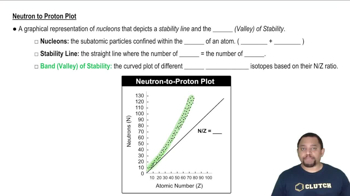Here are the essential concepts you must grasp in order to answer the question correctly.
Isotopes
Isotopes are variants of a particular chemical element that have the same number of protons but different numbers of neutrons. This results in different atomic masses for the isotopes of the same element. Understanding isotopes is crucial for identifying the starting material in nuclear reactions, as the specific isotope will determine the products formed after neutron bombardment.
Recommended video:
Neutron Bombardment
Neutron bombardment is a nuclear reaction where neutrons are directed at a target nucleus, leading to various outcomes such as the formation of new isotopes. In this process, the absorption of a neutron can change the atomic mass of the nucleus without altering its charge, which is essential for determining the resulting isotope after the reaction.
Recommended video:
Nuclear Reactions
Nuclear reactions involve changes in an atom's nucleus and can result in the transformation of one element into another or the formation of isotopes. In the context of the question, understanding how neutron absorption affects the nucleus is key to identifying the original isotope that leads to the formation of Molybdenum-99, as it requires knowledge of the specific nuclear changes that occur.
Recommended video:
 Verified step by step guidance
Verified step by step guidance

